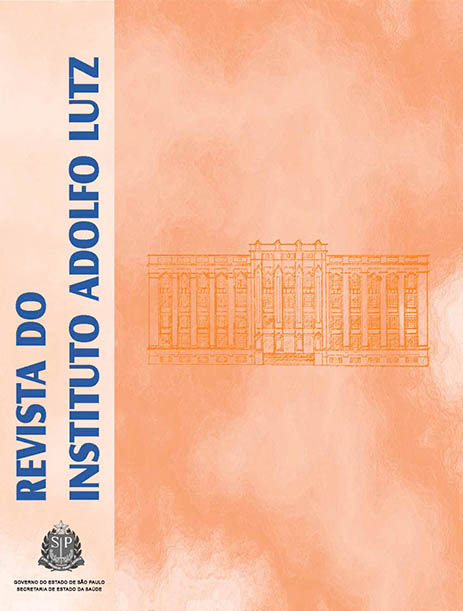Abstract
The present study investigated the impact of multiple and consecutive freeze-thaw cycles on the reactivity of anti-HIV antibodies in stored serum samples by using different methodologies for detecting the specific antibodies. The analyzed sera were part of serum panels (comprised of anti-HIV positive and negative samples), produced at the Center of Immunology – Instituto Adolfo Lutz, which have been the reference specimens for producing internal quality assurance sera of HIV/Aids immunodiagnostic assays. After performing every step of 11 consecutive and multiple freeze-thaw cycles procedure (varying from 7 to 60 cycles), the HIV antibody reactivity in the respective sera was evaluated by means of EIA/ELISA, Western blot and indirect immunofluorescence methodologies. No statistically significant effect on the specific antibody reactivity was found in sera after completing the freeze-thaw process up to 60 cycles. Neither false-negative reactions in HIV antibody positive sera, nor false-positive results in HIV-negative samples were detected.References
1. Brasil. Conselho Nacional de Saúde. RDC nº 441, de 12 de maio de 2011. Aprova as diretrizes para análise ética de projetos de pesquisas que envolvam o armazenamento de material biológico humano ou uso de material armazenado em pesquisas anteriores. Diário Oficial [da] República Federativa do Brasil. Brasília, DF, 18 jul. 2011. Seção 1, nº 136 .p. 60-1.
2. Brasil. Ministério da Saúde. Portaria nº 2.201, de 14 de setembro de 2011. Estabelece as diretrizes nacionais para biorrepositório e biobanco de material biológico humano com finalidade de pesquisa. Diário Oficial [da] República Federativa do Brasil Brasília, DF, 15 set. 2011, Seção 1, nº 178 p. 40-2.
3. Pinsky NA, Huddleston JM, Jacobson RM, Wollan PC, Poland GA. Effect of multiple freezer-thaw cycles on detection of measles, mumps, and rubella virus antibodies. Clin Diagn Lab Immunol. 2003;10(1):19-21.
4. Prolla PA, Clausell N, Fernandes MS, Matte U, Bittelbrunn AC, Hemesath MP, et al. Biobanco do Hospital de Porto Alegre: aspectos técnicos, éticos, jurídicos e sociais. Rev HCPA. 2009;29(1):74-9.
5. Vaught JB, Caboux E, Hainaut P. International efforts to develop biospecimen best practices. Cancer Epidemiol Biomarkers Prev. 2010;19(4):912-5.
6. Krajden M, Minor JM, Rifkin O, Comanor L. Effect of multiple freeze-thaw cycles on hepatitis B virus DNA and hepatitis C virus RNA quantification as measured with branched-DNA technology. J Clin Microbiol.1999;37(6):1683-86.
7. Hsing AW, Comstock GW, Polk BF. Effect of repeated freezing and thawing on vitamins and hormones in serum. Clin Chem. 1989;35(10):2145.
8. Comstock GW, Burke AE, Norkus EP, Gordon GB, Hoffman SC, Helzlsouer KJ. Effects of repeated freeze-thaw cycles on concentrations of cholesterol, micronutrients, and hormones in human plasma and serum. Clin Chem. 2001;47(1):139-42.
9. Campbell LD, Skubitz APN, Somiari SB, Sexton KC, Pugh RS. International Society for Biological and Environmental Repositories (ISBER). 2008 Best Practices for Repositories: Collection, Storage, Retrieval and Distribution Research. Cell Preserv Technol. 2008;6(1):3-58. [acesso 2012 jan 30]. Disponível em:[www.isber.org/bp/bestpractices2008.pdf ].
10. Kirkwood TBL. Predicting the stability of biological standards and products. JSTOR: Biometrics. 1977;33(4):736-4.
11. Gray JJ, Wreghitt TG, McKee TA, McIntyre P, Roth CE, Smith DJ, et al. Internal quality assurance in a clinical virology laboratory. II. Internal quality control. J Clin Pathol. 1995;48:198-202.
12. World Health Organization – WHO. Guidelines for using HIV testing technologies in surveillance. UNAIDS 01.22E, 2001.
13. Cao E, Chen Y, Cui Z, Foster PR. Effect of freezing and thawing rates on denaturation of proteins in aqueous solutions. Biotechnol Bioeng. 2003;83(6):684-90.
14. Franks F. Protein stability: the value of “old literature”. Biophys Chem. 2002;96:117-27.
15. Kronenberg F, Lobentanz E-M, König P, Utermann G , Dieplinger H. Effect of sample storage on the measurement of lipoprotein[a], apolipoproteins B and A-IV, total and high density lipoprotein cholesterol and triglycerides. J Lipid Res. 1994;35:1318-28.
16. Gislefoss RE, Grimsrud TK, Mørkrid L. Stability of selected serum proteins after long-term storage in the Janus Serum Bank. Clin Chem Lab Med. 2009;47(5):596-603.
17. Fipps DR, Damato JJ, Brandt B, Burke DS. Efects of multiple freeze thaws and various temperatures on the reactivity of human immunodeficiency virus antibody using three detection assays. J Virol Methods. 1988;20(2):127-32.
18. São Paulo. Secretaria de Estado da Saúde. Coordenadoria de Controle de doenças. Manual técnico para implementação do controle de qualidade interno nos procedimentos laboratoriais para diagnóstico sorológico da infecção pelo HIV no estado de São Paulo. São Paulo (SP): IAL; 2007. [acesso 2011 dez 6]. Disponível em: [http://bases.bireme.br].
19. Castejon MJ, Yamashiro R, Oliveira CAF, Campos AR, Sartorato MC, Cabral GB, et al. Implementação de controle de qualidade interno (CQI) nos ensaios sorológicos anti-HIV. Produção e distribuição de painéis de soro pelo Instituto Adolfo Lutz Central. BEPA. 2009;6(65):30-2.
20. Brasil. Ministério da Saúde. Portaria nº 686, de 27 de agosto de 1998. Determina o cumprimento das diretrizes estabelecidas das boas práticas de fabricação e controle em estabelecimentos de produtos para diagnóstico in vitro. [acesso 2012 jan 18]. Disponível em: [http://www.anvisa.gov.br/legis/portarias/686_98.htm].
21. World Health Organization – WHO. General requirements for sterility of biological substances (Annex 4). Requirements for biological substances nº 6, 1973.
22. International Standards Organization – ISO. ISO Guide 35: Reference materials – general and statistical principles for certification, ISO. Genebra; 2006.
23. Cardoso MHW, Nóbrega AW, Vital HC, Abrantes SMP. Preparação de um material de referência certificado para controle de agrotóxicos em hortifrutigranjeiros: estudo da estabilidade. Ciênc Tecnol Aliment. 2010;30(2):439-46.
24. Altman DG. Pratical statistics for medical research. Comparing groups – continuous data. Londres: Chapman & Hall; 1991. p. 179-320.
25. Ellison SLR, Barwick VJ, Farrant TJD. Pratical statistics for the analytical scientist – A Bench Guide. Analysis of variance. Cambridge: RSC Publishing; 2009. p. 48-113.1505.indd 58108/05/13 15:58.

This work is licensed under a Creative Commons Attribution 4.0 International License.
Copyright (c) 2012 Instituto Adolfo Lutz Journal
